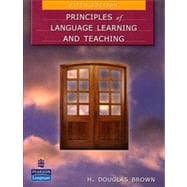Principles of Language Learning and Teaching, Fifth Edition, by H. Douglas Brown, is the classic second language acquisition text used by teacher education programs worldwide. Principles introduces key concepts through definitions of terms, thought-provoking questions, charts, and spiraling. New "Classroom Connections" encourage students to consider the implications of research for classroom pedagogy. An up-to-date bibliography and new glossary provide quick access to important works and key terminology in the field.
The fifth edition takes a comprehensive look at foundations of language teaching through discussions of the latest research in the field, including:
- Vygotsky's and Bakhtin's theories
- Thorndike's law of effect
- error treatment, noticing, recasts
- intercultural communication
- language policy and politics
- corpus linguistics
- "hot topics" in SLA
- connectionism and emergentism
- flow theory, willingness to communicate
- strategies-based instruction
- contrastive rhetoric
- attribution theory, self-efficacy
- output hypothesis
Also by H. Douglas Brown:
Teaching by Principles: An Interactive Approach to Language Pedagogy
Language Assessment: Principles and Classroom Practices
Strategies for Success: A Practical Guide to Learning English








